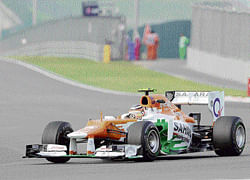Indian Grand Prix promises aplenty
The Indian Grand Prix, which is running for the second year on Sunday at the Buddh International Circuit, was one of the Formula One races that it had once seemed would never happen, could never happen – and then not only did it happen, but when it did it wowed the world.

After Formula One came to China with its race outside Shanghai in 2004, there remained no market in Asia more important for the elite racing series to break into than India.
With a population of 1.2 billion the country was a potentially lucrative market for the series and its sponsors.
Formula One races had begun to be televised in India regularly in the 1990s. Vijay Mallya went on from sponsorship into team ownership, creating the Force India team in 2008. There had been Indian drivers in the series.
Narain Karthikeyan raced with the Jordan team in 2005 and was a test driver at the Williams team for a couple of seasons after that. This year he is driving for the HRT team. Karun Chandhok started racing in the series at the new Hispania team in 2010 and also drove for Lotus in 2011.
Indeed, all that was missing was an Indian Grand Prix. Mallya and Chandhok’s father, Vicky, had been pushing for one for years, via the Indian auto-racing organisation. But in the modern version of Formula One that was expanding around the world, virtually all of the new races had come about thanks to funding by local governments.
By 2007, five sites around the country were being considered. In the end, Formula One signed a deal for the race with the Indian Olympic Association. It was decided to build the circuit in Greater Noida, outside New Delhi, with funding entirely from the private sector.
Even then, it looked as if the race would never really happen. The Grand Prix was announced for 2009, then 2010, and finally 2011. Given this tumultuous history, but also because of the widely criticized organisation of the Commonwealth Games staged in New Delhi in 2010, skeptics around the world wondered if India was capable of hosting an international sporting event of such magnitude.
Then, racing against time and employing thousands of workers one of the world’s great sporting stadiums was build, with a gargantuan, curved awning overhanging the 13,000 seats in the grandstand of the main straight and a world-class pit and paddock area. The organisers had fulfilled their commitment to Formula One to perfection.
The track itself also surpassed expectations. Because it had been completed at the last minute, many drivers and teams had feared that it would not be ready for racing. It was covered with dust, and many expected a fiasco of a race.
In the end, however, the opposite happened. The track produced a surprisingly uneventful race. It was difficult for drivers to overtake, there were only a few minor incidents, and Sebastian Vettel won, taking his 11th victory of the season for the Red Bull team.
“We enjoyed the country, and the circuit was pretty good, the layout,” said Heikki Kovalainen, a driver at the Caterham team. “Maybe the facilities were still a bit half-ready but the circuit was good.”
India itself came out looking like a winner, as the world’s media painted a picture of great accomplishment against the odds. There was barely a negative report about the race. The fans proved to be among the most knowledgeable in the world. A total of 100,000 attended, filling the grandstand with the promise of a great future for the grand prix and helping justify the private enterprise that had created it.
“But normally there is a little bit of a dip with the second year,” said Karthikeyan, the only Indian driver now in the series. “But there is definitely a lot of interest in Formula One. And people are aware of the sport in a much bigger way than two years ago because we have had a Grand Prix.”
“But it is still very expensive for Indians to go to the Grand Prix,” he added, “and to have nice seats, you’re looking at 400 euros. But there is suddenly a lot of interest in the sport and I hope it will be for many years to come.”
In fact, although it is still out of reach for the majority of Indians, the race ended up fulfilling one of its main roles for the wealthy: As a place for business-to-business activity, it instantly became one of the most popular for the corporate team sponsors, potential sponsors and their guests to meet.
“Last year, India was our third-biggest attendance of the Paddock Club and sponsors and guests, and this year it’s probably about the same again,” said John Booth, director of the Marussia team, referring to the corporate hospitality business. “It’s very popular for them.
“India has really sparked people’s imaginations,” he added. “It is really exciting. Even the traffic jams are interesting.”
Deccan Herald is on WhatsApp Channels| Join now for Breaking News & Editor's Picks